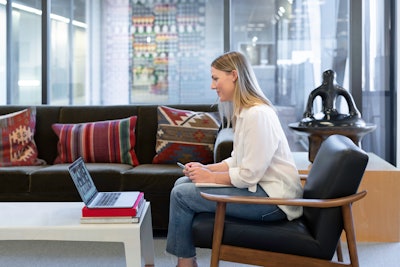
Gilles Bertaux is co-founder and CEO of Livestorm, a video engagement platform founded in 2016 that manages meetings, webinars and virtual events from start to finish.
 Gilles BertauxPhoto: Courtesy of Livestorm
Gilles BertauxPhoto: Courtesy of Livestorm
The increasingly common hybrid work model, which blends remote and in-office time, has some distinct advantages—especially for work-life balance—but there are areas that can become more challenging. Just think back to ye olde days when everyone was in the office. We had impromptu brainstorming sessions around the lunch table, talked strategy in the elevator and solved complex problems in the white space between meetings. It all came so naturally.
When there’s physical distance involved, we’re much less likely to have those serendipitous run-ins and opportunistic conversations. Still, that doesn’t mean those types of discussions have to be a thing of the past. They just have to be a bit more orchestrated as part of the new normal workflow. One of the most seamless ways to do that is to build space and time into your existing virtual meetings by adding breakout rooms.
A breakout room is a dedicated space in which a small group of people can get together to solve problems, have short discussions or network. In the physical world, we often see these during workshops, networking events or even large conferences. They can be equally effective when implemented during the virtual versions of those same types of events, as well as in your everyday group video meetings.
Whether online or IRL, breakouts are typically called by the meeting’s hosts in order to give attendees the opportunity to discuss a topic in more detail. After a set period of time, they’ll return to the main event room, and the conference will continue.
When part of a video conference, breakout rooms offer a dedicated space in which colleagues can talk about the meeting’s topics in more detail. For example, some employees may have questions about a project you mentioned during the meeting, or you might want to host a brainstorming session with some key stakeholders. You could go into a virtual breakout room to have these specific discussions, then return to the main session.
Not only does using a virtual breakout room help bring people together regardless of the physical distance between them, it can also make it easier to avoid being distracted. According to a recent survey on workplace distractions conducted by trade organization Mopria Alliance, employees face some sort of distraction about twice an hour. Whether respondents were working from home or in the office, their attention was diverted primarily by the same things: checking email, browsing the Internet, having unscheduled conversations and so on.
Just the fact that we’re constantly trying to deal with a flood of emails, Slack messages, task management notifications and other intrusions doesn’t just cost us productivity—it stresses us out. And as more unread messages and uncompleted tasks pile up, problem-solving gets more complicated, as does engaging productively with coworkers.
Of course, just creating a space doesn’t mean it will be used most effectively. Here are four simple tips you can use to ensure you and your employees get the greatest benefits from virtual breakout rooms.
1. Focus on one problem at a time.
Unlike a virtual team meeting, which typically covers a variety of topics, breakout sessions should be more keenly focused on a single issue. For example, a product development team might have a standing weekly meeting during which they review the status of all their current projects. As part of that meeting, there could be a breakout room in which the team involved in one particular project focuses on discussing potential solutions for a single problem, like how to fix a recurring bug. It’s a topic that wouldn’t have “fit” in the all-hands call, but if taken “offline,” might have eaten up hours with back-and-forth emails and chat messages.
2. Develop standards for breakout room etiquette.
As we already noted... SQUIRREL! Now, where was I? Oh, yes, distraction.
On average, twice an hour, something interrupts us. If you’re a team of 10 people on a call for an hour, that’s 20 separate instances of lost focus. We can reduce that number considerably and encourage attentiveness by implementing a few simple ground rules.
An easy one to start with is requesting all participants sign out of email and chat applications. They should also mute any other notifications to ensure their colleagues don’t have a Pavlovian response to that familiar sound of calendar reminder. And although the sudden appearance of kids and pets can be fun, their screaming and barking isn’t—so attendees should mute their microphones whenever they aren’t speaking.
3. Use a timer.
Another way you can fairly easily avoid having two distractions per hour ruin your meeting is to have a shorter meeting. In the “agile” method of project management, it’s common for teams to have a daily standup meeting lasting no longer than 15 minutes. Believe it or not, setting this time limit as an internal rule helps the individuals involved to self-organize.
Additionally, very few people look forward to long, drawn-out meetings—and anticipating boredom, they might be tuned out from the get-go. By setting clear limits, you’re letting people know that this time will be used efficiently and setting up a situation where they’ll be ready, willing and able to focus on the topic at hand.
4. Leverage available tools to facilitate the discussion.
In the physical world, we set up spaces for collaboration, providing tools and materials that will encourage active participation. The same should be true when arranging spaces for virtual interactions. Where we may have had a whiteboard, pens and pads of paper in the office, the breakout room can give attendees access to digital alternatives like screen sharing, virtual white boards and note-taking tools. Virtual breakout rooms also offer something that we often don’t have IRL: the ability to record and playback the session so nothing gets lost, even if... SQUIRREL!
There’s a lot of value to be had by adding breakout rooms to your existing virtual communications toolbox. Much like the way colleges complement huge lecture-based classes with separate, smaller workshops that give opportunity for deeper discussion and understanding of the course material, breakout rooms help make large meetings more personal, meaningful and productive.
Instead of a long, dull monologue, attendees get the opportunity to interact, ask questions, provide feedback, develop key takeaways and understand what exactly their action items are. Virtual meetings may never fully replace their in-person counterparts, but by adding breakout rooms, they can be equally—or perhaps even more—effective.



















